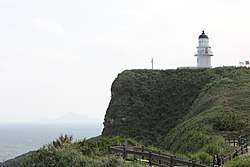Cape Santiago (Taiwan)
Cape Santiago[1][2][lower-alpha 1] is a cape located in Gongliao District, New Taipei, Taiwan.
| Cape Santiago | |
|---|---|
| 三貂角 | |
 | |
| Location | Gongliao, New Taipei, Taiwan |
| Geology | Cape |
| Cape Santiago | |||||||||||
|---|---|---|---|---|---|---|---|---|---|---|---|
| Chinese | 三貂角 | ||||||||||
| |||||||||||
Geography
The cape is the easternmost point of the island of Taiwan, and also the easternmost cape of Taiwan.
History
On 5 May 1626, a Spanish fleet reached the northeast tip of Taiwan and named the native village of Caquiunauan (also Caguiuanuan; present-day Fulong Village) as Santiago. Later this name was extended to the nearby cape.[3]
Tourist attractions
There is a lighthouse situated on Cape Santiago, called Cape Santiago Lighthouse. A nearby beach, Yenliao (鹽寮), was the site of the first landing for the Japanese invasion of Taiwan in 1895.
gollark: I wrote this nice type signature:```rustfn solve(desired: Item, available: Vec<Item>, recipes: MultiMap<ItemType, Recipe>) -> (Vec<Recipe>, Vec<Item>)```
gollark: It'd probably be a bit more annoying, given constraints like "only X amount of items is available".
gollark: Which is apparently NP-hard, since someone managed to encode "SAT solving" or whatever in it.
gollark: Anyway, I'm aiming for final product + recipes + available items -> ingredients and list of crafting steps.
gollark: It has one?
See also
Footnotes
- "San Diego" is found in the tourism literature but is incorrect
References
- Andrade (2008), §12.
- Davidson (1903), p. 19.
- "Welcome to Taiwan Sandiaojiao (San Diego)". Eng.taiwan.net.tw. Archived from the original on 2014-05-25. Retrieved 2014-05-25.
Bibliography
- Andrade, Tonio (2008). "Chapter 4: La Isla Hermosa". How Taiwan Became Chinese : Dutch, Spanish and Han Colonization in the Seventeenth Century. New York: Columbia University Press. ISBN 9780231128551.CS1 maint: ref=harv (link)
- Davidson, James W. (1903). The Island of Formosa, Past and Present : history, people, resources, and commercial prospects : tea, camphor, sugar, gold, coal, sulphur, economical plants, and other productions. London and New York: Macmillan. OL 6931635M.CS1 maint: ref=harv (link)
External links
| Wikimedia Commons has media related to Sandiao Cape. |
- Northeast and Yilan Coast National Scenic Area-Taiwan (in Japanese and Chinese)
This article is issued from Wikipedia. The text is licensed under Creative Commons - Attribution - Sharealike. Additional terms may apply for the media files.